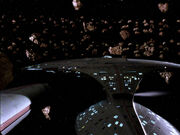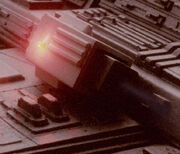Renegade54 (talk | contribs) m (formatting) |
mNo edit summary |
||
| (12 intermediate revisions by 8 users not shown) | |||
| Line 1: | Line 1: | ||
[[File:USS Enterprise-D maneuvering thruster.jpg|thumb|The ''Enterprise''-D using maneuvering thrusters]] |
[[File:USS Enterprise-D maneuvering thruster.jpg|thumb|The ''Enterprise''-D using maneuvering thrusters]] |
||
[[File:Maneuvering thruster.jpg|thumb|A thruster module from the ''Enterprise''-D propels a stricken vessel]] |
[[File:Maneuvering thruster.jpg|thumb|A thruster module from the ''Enterprise''-D propels a stricken vessel]] |
||
| − | '''Maneuvering thrusters''' |
+ | '''Maneuvering thrusters''' or '''maneuvering jets''', often simply known as '''[[thruster]]s''' or '''jets''', were used by [[starship]]s and other spacecraft to make precise movements in lieu of primary [[impulse drive|impulse]] or [[warp engine]] use. [[Proton's rocket ship]], a [[fiction]]al [[rocket ship]], operated with the, theoretically, similar form of propulsion known as '''steering jets'''. |
| + | == Operations == |
||
| ⚫ | |||
| + | The thrusters were low-{{dis|power|physics}} reaction control jets that could be used for fine translational and [[attitude control|attitudinal control]], including [[station-keeping]]. They were most typically used in docking or similar maneuvers. ({{film|1}}; {{film|11}}; {{TNG|Booby Trap}}) |
||
| − | All reaction-based technologies operated on the Newtonian principle of the "Law of Inertia": that |
+ | All reaction-based [[technology|technologies]] operated on the Newtonian principle of the "Law of Inertia": that an object in motion will stay in motion unless acted upon by an external force. This was similar in some ways to [[impulse engine]] technologies and thrusters were sometimes called [[impulse thruster]]s or maneuvering jets. ({{DS9|Rocks and Shoals}}; {{TNG|Encounter at Farpoint|Coming of Age}}) |
| − | On a {{ |
+ | On a {{class|Constitution II}}, the maneuvering thrusters were placed along the outer edges of the [[hull]]. ({{film|1}}) In [[Starfleet]] during the [[24th century]], maneuvering thrusters were part of the [[reaction control system]] and were also placed in similar positions. ({{VOY|The Cloud}}) These were typically placed in groups of four or "quads" on starships. ({{TNG|Final Mission}}; {{ENT|Future Tense}}) |
| + | |||
| ⚫ | |||
| + | |||
| + | == History == |
||
| + | In [[2153]], [[Travis Mayweather]], while [[pilot]]ing ''[[Shuttlepod 2]]'' away from an [[asteroid]], lost the left thruster due to [[debris]] from the asteroids. He made it back to {{EnterpriseNX}} only using the right thruster. ({{ENT|Impulse}}) |
||
{{bginfo|The term "maneuvering thrusters" was initially used in ''Star Trek: The Motion Picture''. It was never heard in [[TOS]] or [[TAS]].}} |
{{bginfo|The term "maneuvering thrusters" was initially used in ''Star Trek: The Motion Picture''. It was never heard in [[TOS]] or [[TAS]].}} |
||
| + | {{pna-incomplete}} |
||
| + | |||
| + | == External link == |
||
| ⚫ | |||
| − | === Appearances === |
||
| − | <div class="appear"> |
||
| ⚫ | |||
| − | **{{e|Broken Bow}} |
||
| − | **{{e|Strange New World}} |
||
| − | **{{e|Future Tense}} |
||
| − | **{{e|Impulse}} |
||
| − | *[[Star Trek films|Movies]]: |
||
| − | **{{film|1}} |
||
| − | **{{film|2}} |
||
| − | **{{film|6}} |
||
| − | **{{film|7}} |
||
| − | **{{film|10}} |
||
| − | **{{film|11}} |
||
| − | *{{TNG}} |
||
| − | **{{e|Encounter at Farpoint}} |
||
| − | **{{e|Booby Trap}} |
||
| − | **{{e|The Best of Both Worlds, Part II}} |
||
| − | **{{e|The Pegasus}} |
||
| − | *{{DS9}} |
||
| − | **{{e|The Siege}} |
||
| − | **{{e|For the Uniform}} |
||
| − | **{{e|Rocks and Shoals}} |
||
| − | **{{e|Penumbra}} |
||
| − | *{{VOY}} |
||
| − | **{{e|The Cloud}} |
||
| − | **{{e|Elogium}} |
||
| − | **{{e|Thirty Days}} |
||
| − | **{{e|Think Tank}} |
||
| − | </div> |
||
[[Category:Propulsion technology]] |
[[Category:Propulsion technology]] |
||
Latest revision as of 19:09, 23 May 2023

The Enterprise-D using maneuvering thrusters

A thruster module from the Enterprise-D propels a stricken vessel
Maneuvering thrusters or maneuvering jets, often simply known as thrusters or jets, were used by starships and other spacecraft to make precise movements in lieu of primary impulse or warp engine use. Proton's rocket ship, a fictional rocket ship, operated with the, theoretically, similar form of propulsion known as steering jets.
Operations
The thrusters were low-power reaction control jets that could be used for fine translational and attitudinal control, including station-keeping. They were most typically used in docking or similar maneuvers. (Star Trek: The Motion Picture; Star Trek; TNG: "Booby Trap")
All reaction-based technologies operated on the Newtonian principle of the "Law of Inertia": that an object in motion will stay in motion unless acted upon by an external force. This was similar in some ways to impulse engine technologies and thrusters were sometimes called impulse thrusters or maneuvering jets. (DS9: "Rocks and Shoals"; TNG: "Encounter at Farpoint", "Coming of Age")
On a Constitution II-class, the maneuvering thrusters were placed along the outer edges of the hull. (Star Trek: The Motion Picture) In Starfleet during the 24th century, maneuvering thrusters were part of the reaction control system and were also placed in similar positions. (VOY: "The Cloud") These were typically placed in groups of four or "quads" on starships. (TNG: "Final Mission"; ENT: "Future Tense")
Within Federation spacedocks, all vessels were required to stay at maneuvering thrusters until they had cleared the outer space doors. (Star Trek II: The Wrath of Khan, Star Trek VI: The Undiscovered Country)
History
In 2153, Travis Mayweather, while piloting Shuttlepod 2 away from an asteroid, lost the left thruster due to debris from the asteroids. He made it back to Enterprise NX-01 only using the right thruster. (ENT: "Impulse")
External link
- Maneuvering thruster at Memory Beta, the wiki for licensed Star Trek works
